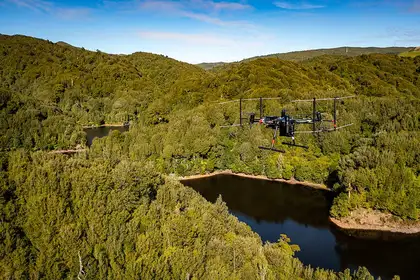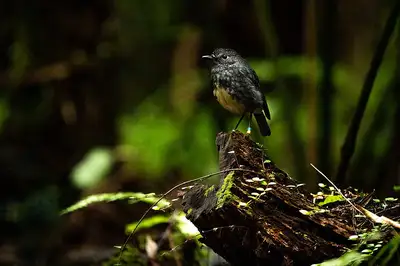
The Drone Ranger was designed by Massey student Chris Muller as part of his PhD in partnership between Massey and the University of Canterbury.
Massey University PhD student Chris Muller’s novel ‘Drone Ranger’ technology is being used to track the 40 Toutouwai North Island robins that were translocated to Palmerston North’s Turitea Dam in April.
And the innovative device could have much wider applications - his ultimate goal is to make the new technology available to wildlife researchers to revolutionise conservation around the world.
After a successful translocation from Bushy Park Tarapuruhi Forest Sanctuary near Whanganui, the next focus was to monitor the birds’ survival rates and whether they were staying within the roughly 4000 hectares of predator-controlled forest.
Each bird was fitted with a small transmitter, weighing less than 0.7 grams, so they could be tracked using a drone fitted with a custom-designed VHF radio receiver.

Each bird was fitted with a small transmitter so researchers could check on them following the translocation.
Massey researcher Dr Zoe Stone has been monitoring the birds as part of a Ministry for Business Innovation and Employment-funded project – a collaboration between the university and Manaaki Whenua Landcare Research, to better understand the success of translocation projects in large areas of bush.
Dr Stone says Toutouwai are particularly vulnerable to predators during the breeding season in spring and summer when females are nesting and have eggs and chicks.
“We will need to wait until spring to find out how successful this translocation might be, but so far, following 10 weeks of monitoring in the reserve using a combination of ground and aerial tracking methods, we have found many of the birds have started to establish territories and pair up.”
New drone technology saves time, money and improves data when tracking wildlife
The Drone Ranger aerial tracking system was designed by fellow student Chris Muller as part of his PhD, in a partnership between Massey University and the University of Canterbury. It was developed to help reduce the time and cost of tracking wildlife by foot. It uses ground-breaking new technology which is more efficient than traditional radio receivers, and can simultaneously track up to 500 animals while the drone cruises overhead.
Dr Stone says using the Drone Ranger made monitoring quicker and easier. In what could have required days of off-track hiking through dense and hilly bush, the researchers were able to fly the drone and locate birds in as little as 10 minutes, including over gullies with thick forest where signal detection is difficult. Using the drone also helped them to locate transmitters that had fallen off the birds, rather than thinking a bird was missing and may have died.
“Being able to collaborate with Chris directly has been fantastic for this project. Drone technology for wildlife tracking has great potential for improving data collection and providing high quality data with reduced field effort,” she says.
Of the 40 birds translocated, half appear to have settled and paired up, with around 10 possible pairs. The other birds seem to be a little less settled, but are alive have been tracked moving around the reserve, still looking for the best territory and mate.
The project began five years ago when the Palmerston North City Council and local iwi Rangitāne decided to reintroduce the birds as part of the restoration programme for the Turitea Reserve following the 20-year predator control programme. The translocation is a gifting of these taonga Rangitāne from Ngā Rauru, the tangata whenua of Bushy Park Tarapuruhi.
Toutouwai were the first species to be reintroduced because they are an easy species to catch and, based on previous research, are predicted to have a higher chance of survival.
“The Turitea population will be monitored for a few years to make sure females are surviving the breeding season and reproducing, and that any juveniles are remaining in the reserve and not leaving.”
Chris says it was a proud moment seeing the Drone Ranger be used to watch over the robins. “It is great to see a wider use for the technology from my PhD, and the successful robin reintroduction is a great outcome for the species and the community.”